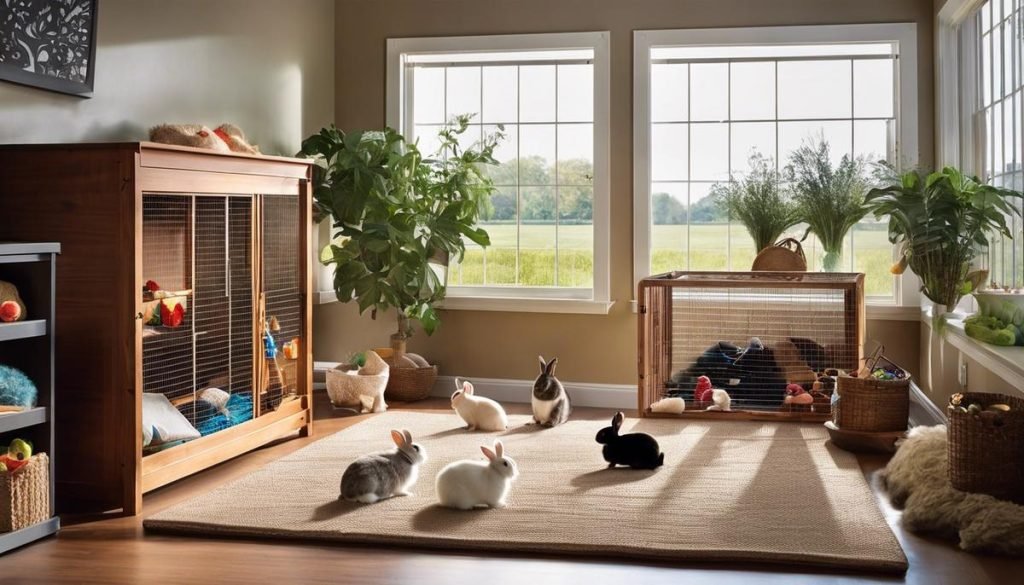When it becomes necessary to shift a rabbit from an outdoor environment to an indoor one, it can be a simple or a complex move based on how well-informed and prepared you are as a pet parent. This transition could encompass several changes, including different care routines, potential health and behavioral changes, and setting up a comfortable and stimulating indoor habitat. Understanding the Indoor Rabbit Care Essentials is the first step towards ensuring a smooth transition. It covers essential aspects such as the rabbit’s dietary needs, the favorable cage size, and the type and extent of exercise required.
Understanding Indoor Rabbit Care Essentials
Embracing Change: Fundamental Care Tips For Bringing Your Outdoor Rabbit Inside!
Hello dear friends, delighted as always to share another page filled with warm energy and useful advice. This time, let’s put a spotlight on those furry buddies that hop around our backyards, the adorable rabbits.
If there’s a recent decision to transition your outdoor rabbit to an indoor lifestyle, there are several fundamental care aspects to consider. This helps ensure a smooth transition and keeps your fluffy friend healthy and happy. It’s vital to remember- every rabbit is unique with individual needs, so tailoring their care to suit them is key.
One of the first practical aspects to tackle is living space. Rabbits need space to explore and exercise. An indoor cage must provide enough space for your bunny to stretch, hop, and do those adorable bunny 360-degree ‘binkies’! Also, it should contain spaces to hide, eat, and use the toilet.
Rabbits enjoy comfort and love to nest. So, adding soft bedding materials such as hay to their indoor space can mimic their outdoor habitat and help them feel at home.
Now, when happy hopper comes inside, pay attention to the temperature. Rabbits are sensitive to atmospheric changes. Maintain a stable, comfortable temperature inside your home since any extreme in temperature can lead to health problems.
Rabbits are super social animals, too. They relish companionship. An indoor life can mean more human interaction, but also consider pairing them with another rabbit if feasible. Keep in mind: proper introduction and bonding therapy are elemental to drive those bunny blues away!
Even with careful in-house guidance, rabbits will still maintain some of their outdoor instincts. Their love for burrowing and chewing can lead to surprising house damages. Bunny-proofing your home is essential. Protect electric cords, upholsteries and wooden furniture by providing safe chewing alternatives like untreated apple wood sticks or rabbit friendly toys.
Next, let’s hop onto diet. A healthy diet for indoor rabbits is paramount. Consistently provide access to fresh hay (the mainstay of bunny meals), a handful of leafy greens and a controlled portion of rabbit pellets. Fresh water, ideally from a heavy ceramic bowl, should always be available.
Finally, regular grooming is a must. Brushing your rabbit not only helps keep their fur clean but also promotes a bond between you two. Long-haired breeds will often require extra grooming attention.
As this journey begins, expressing patience and love helps the transition go along more smoothly. Embracing this change may bring challenges, but the rewards garnered from a much closer bond with your bunny companion are priceless. So, cozy up a corner, prep for bunny-proofing, and let’s welcome these lovable creatures into our hearts and homes.

Health and Behavior Adjustments
Enhancing Indoor Life for Your Furry Friend: Transitioning Rabbits from Outdoors
As any devoted parent knows, adjusting to change can be challenging, in humans as well as animals. Rabbits, which are gaining popularity as indoor pets, are no exception. While providing a stress-free transition from outdoor to indoor living for your rabbit may seem daunting, incorporating simple measures can make the adaptation process smoother and healthier.
Engaging in Play and Exercise: The Role of Stimulating Environment
Shifted indoors, rabbits need additional stimulation for their active minds. Their precious playful nature, after all, is one of the reasons we adore them! Introduce puzzle toys or an old phone book for them to shred. Ensure they have sufficient space to run, hop and exercise. By meeting their need for physical activities, you can prevent them from getting bored or depressed.
Safeguarding Health: Vet Visits and Healthcare
Regular health check-ups are essential, especially during transition periods that may bring unfamiliar stresses to a bunny’s system. Establishing a good relationship with your local veterinarian can ensure your rabbit receives the right vaccinations and preventative care to keep them healthy indoors. Monitoring your pet’s health more frequently during the initial transition phase can help catch any health issues early.
Navigating Indoor Hazards: Litter-training and Hygiene
Just like little children, rabbits also have a learning curve when it comes to adjusting to a new home environment. Although typically neat animals, litter-training may present a bit of a challenge initially. Use rabbit-safe, absorbent litter material, place a few droppings to provide them the right hint, and patiently wait for them to grasp the idea. Remember to keep their eating and relieving areas well separated, as rabbits dislike messiness!
Adapting their Drinking Styles: Water Bottles vs. Bowls
Used to drinking from a water dish outside, the sudden transition to a water bottle can confuse many bunnies. Some rabbits may even resist the change, risk dehydrating themselves. Include both, a water dish and a water bottle in their living space till they adapt to the bottle, ensuring your bunny stays well-hydrated.
Focused Attention: Handling and Bonding
Bonding plays a key role in a smooth transition. Rabbits are social animals and crave interaction. Hold and pet them consistently but gently, enabling trust and closeness to develop. In time, your house will become their haven, and you will be their secure port.
While excited squeals of children may be a joyous soundtrack of your home, rabbits may find loud noises and quick movements startling and stressful. Teach children to engage with the rabbit calmly and gently, acquainting everyone with the needs of a new, furry family member.
Every home, every family, and every rabbit is unique, with different needs and behaviors. As you navigate through this transition, remember that the goal is the same: to provide a loving, comfortable environment for your pet bunny.
Lastly, the unexpected bumps in this transition journey shouldn’t deter your determination. Instead, look at them as opportunities, a chance to understand your rabbit better. The bond that will emerge as a result of this journey will last hop-ily ever after!

Creating a Comfortable Indoor Habitat
Engaging in Play and Exercise: The Role of a Stimulating Environment
While indoor rabbits might not have natural wilderness to explore, simulating a comparable environment within your home is essential. This involves providing a variety of toys, tunnels to crawl through, and platforms to jump on to ensure their little bunny bodies get the exercise they need. Regular playtime outside the cage is equally vital for mental stimulation and physical wellbeing.
Safeguarding Health: Regular Vet Visits and Healthcare
Regular vet visits are key in safeguarding your rabbit’s health. They need vaccinations against diseases like Myxomatosis and Viral Hemorrhagic Disease, as well as periodic check-ups to monitor their general health. Chew toys are a great way to help maintain healthy teeth, as this can be a common health issue in rabbits.
Navigating Indoor Hazards: Litter-training and Hygiene
Hygiene is critical, especially when there are children in the house. Litter training your rabbit can take time and patience, but it’s not impossible, as rabbits are naturally clean animals. Offering treats as a reward when they use the litter box can reinforce good habits.
Adapting their Drinking Styles: Water Bottles vs. Bowls
Keeping your rabbit hydrated is a no-brainer. While water bottles are a popular choice because they don’t tip over easily, some rabbits may prefer bowls. It’s essential to try both and see which one your fluffy friend prefers – as long as they’re guzzling down that water!
Focused Attention: Handling and Bonding
Like humans, rabbits crave interaction and bonding. Regular petting, kind words, and gentle handling can help cultivate a bond with your rabbit, making them feel secure in their new home. However, remember to never lift a rabbit by their ears, a common myth which can harm them.
Teaching Children to Interact with Rabbits
Explaining the rabbit’s needs and unique characteristics to children is crucial, especially when it comes to handling these delicate creatures. Encouraging gentle stroking and at-level interactions will provide a safe experience for both the child and the rabbit, fostering a bond as well.
Understanding Unique Rabbit Needs and Behaviors
Rabbits have unique behaviors like digging, chewing, and thumping. Instead of discouraging this, provide safe alternatives, like chewable toys or cardboard for digging. Understand their ‘binky’ (a wild jump in the air) is not a sign of fear, but a display of their happiness and contentment.
Overcoming Unexpected Challenges
Adopting a pet comes with challenges. Rabbits might show signs of stress or discomfort, or they might resist litter training. They could be shy or scared initially. Remember, patience is key. With a loving environment and dedicated care, your indoor rabbit will feel right at home in no time.

Shifting an outdoor rabbit to an indoor setting requires knowledge and attention to detail. However, with a firm grasp on Indoor Rabbit Care Essentials, the understanding of possible Health and Behavior Adjustments, and the ability to create a Comfortable Indoor Habitat, you can provide a healthy and stimulating environment for your rabbit. Ensuring your rabbit’s mental and physical well-being through this transition will not only relieve it off stress but also promote a deeper bond between you two. After all, the goal is to make our furry friends feel as comfortable and loved as possible in their new homes.



